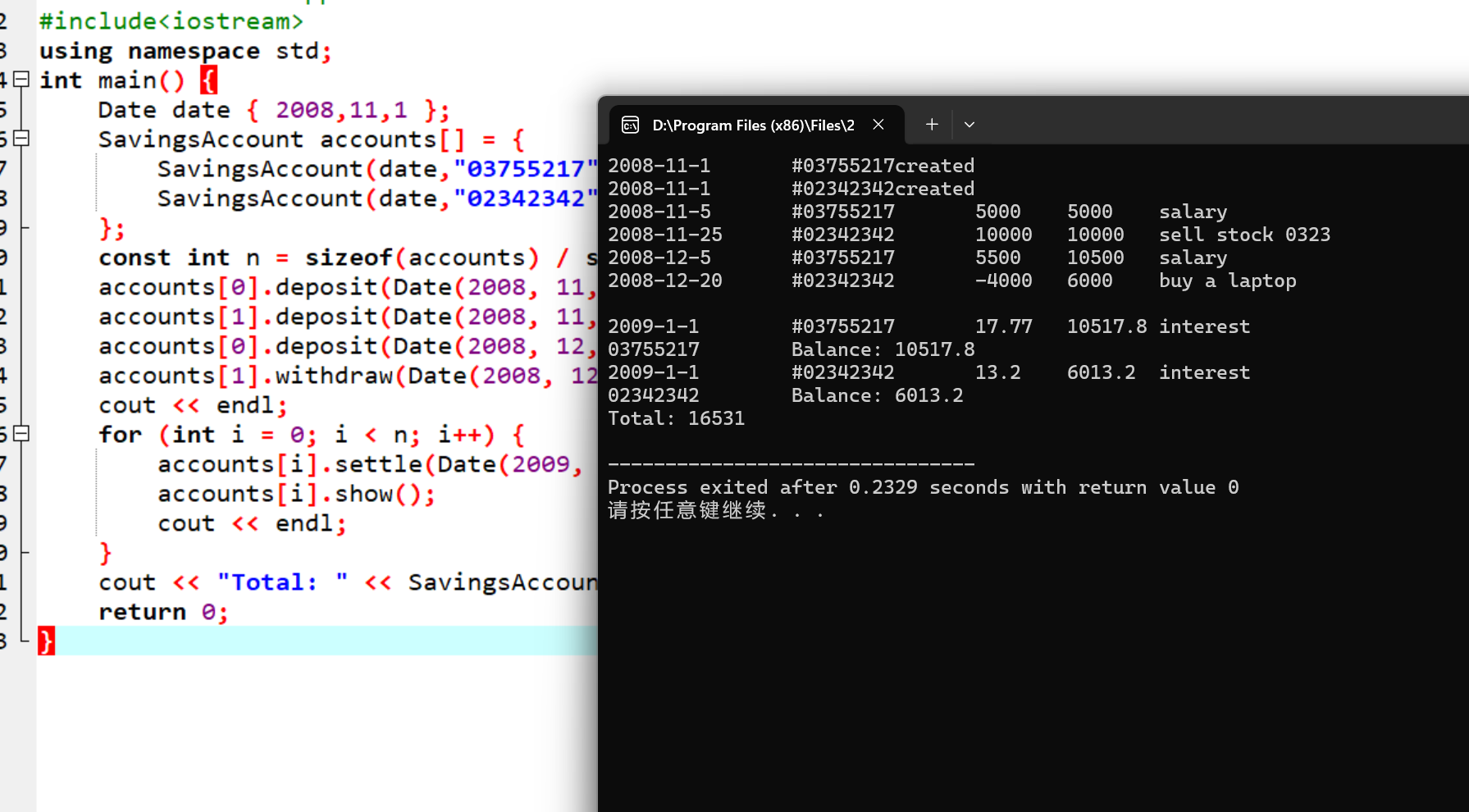实验3
实验任务1:
button.hcpp
#pragma once #include <iostream> #include <string> using std::string; using std::cout; // 按钮类 class Button { public: Button(const string &text); string get_label() const; void click(); private: string label; }; Button::Button(const string &text): label{text} { } inline string Button::get_label() const { return label; } void Button::click() { cout << "Button '" << label << "' clicked\n"; }
window.hpp
class Window{ public: Window(const string &win_title); void display() const; void close(); void add_button(const string &label); private: string title; vector<Button> buttons; }; Window::Window(const string &win_title): title{win_title} { buttons.push_back(Button("close")); } inline void Window::display() const { string s(40, '*'); cout << s << endl; cout << "window title: " << title << endl; cout << "It has " << buttons.size() << " buttons: " << endl; for(const auto &i: buttons) cout << i.get_label() << " button" << endl; cout << s << endl; } void Window::close() { cout << "close window '" << title << "'" << endl; buttons.at(0).click(); } void Window::add_button(const string &label) { buttons.push_back(Button(label)); }
task1.cpp
#include "window.hpp" #include <iostream> using std::cout; using std::cin; void test() { Window w1("new window"); w1.add_button("maximize"); w1.display(); w1.close(); } int main() { cout << "用组合类模拟简单GUI:\n"; test(); }
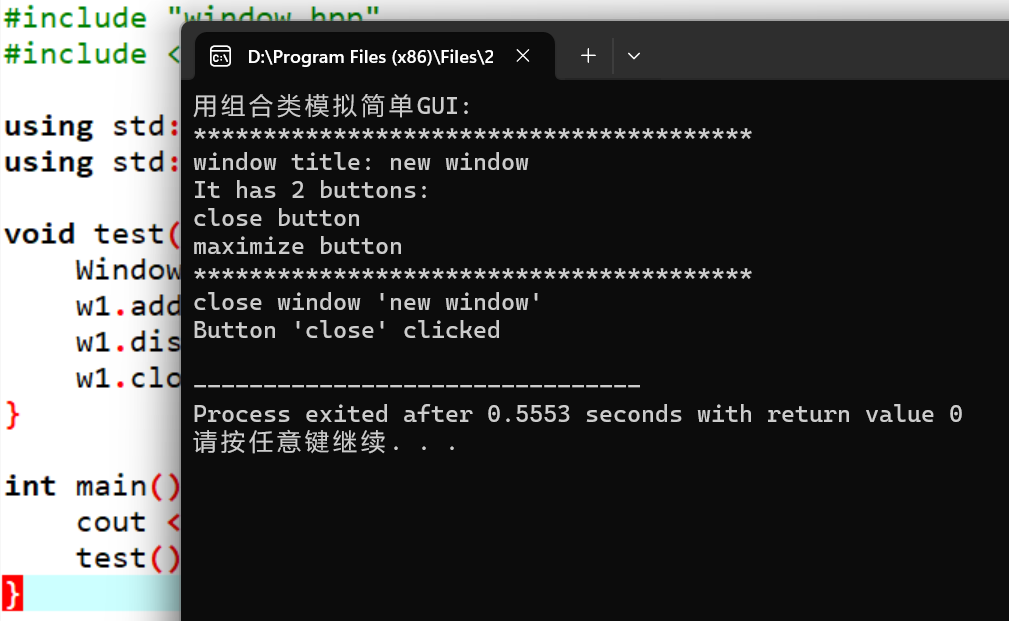
Q1:自定义了两个类,分别是Button(按钮类)和Window(窗口类);使用到了标准库的string类和vector类;Window类和Button类之间存在组合关系,vector类和Button类之间存在组合关系
Q2:不适合,const的作用是不让编译器改变变量的值,起到保护作用,加const的函数都是如展示display等不需要改变变量的函数,其他要改变的不能加const。而加inline是因为display操作调用次数较多,用内联函数来可以节省时间。
Q3:构建一个长度为40的字符串。
实验任务2:
#include <iostream> #include <vector> using namespace std; void output1(const vector<int> &v) { for(auto &i: v) cout << i << ", "; cout << "\b\b \n"; } void output2(const vector<vector<int>> v) { for(auto &i: v) { for(auto &j: i) cout << j << ", "; cout << "\b\b \n"; } } void test1() { vector<int> v1(5, 42); const vector<int> v2(v1); v1.at(0) = -999; cout << "v1: "; output1(v1); cout << "v2: "; output1(v2); cout << "v1.at(0) = " << v1.at(0) << endl; cout << "v2.at(0) = " << v2.at(0) << endl; } void test2() { vector<vector<int>> v1{{1, 2, 3}, {4, 5, 6, 7}}; const vector<vector<int>> v2(v1); v1.at(0).push_back(-999); cout << "v1: \n"; output2(v1); cout << "v2: \n"; output2(v2); vector<int> t1 = v1.at(0); cout << t1.at(t1.size()-1) << endl; const vector<int> t2 = v2.at(0); cout << t2.at(t2.size()-1) << endl; } int main() { cout << "测试1:\n"; test1(); cout << "\n测试2:\n"; test2(); }
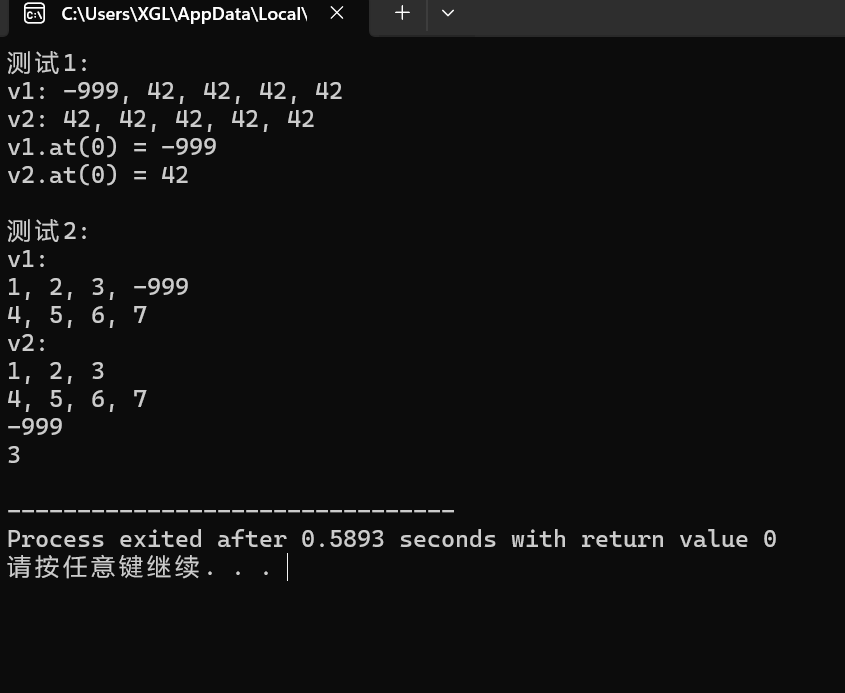
Q1:
1:构造并初始化5个42
2:拷贝构造v1
3:at访问
Q2:
1:初始化v1为两个{1,2,3}和{4,5,6,7}
2: 拷贝构造v1
3:在尾端插入v1.at(0)
Q3:
1:初始化t1为v1.at(0) t1能够进行修改
2:输出
3:初始化t2为v2.at(0) t2不能进行修改
4:输出
实验任务3:
task3.cpp
#include "vectorInt.hpp" #include <iostream> using std::cin; using std::cout; void output(const vectorInt &vi) { for(auto i = 0; i < vi.get_size(); ++i) cout << vi.at(i) << ", "; cout << "\b\b \n"; } void test1() { int n; cout << "Enter n: "; cin >> n; vectorInt x1(n); for(auto i = 0; i < n; ++i) x1.at(i) = i*i; cout << "x1: "; output(x1); vectorInt x2(n, 42); vectorInt x3(x2); x2.at(0) = -999; cout << "x2: "; output(x2); cout << "x3: "; output(x3); } void test2() { const vectorInt x(5, 42); vectorInt y(10, 0); cout << "y: "; output(y); y.assign(x); cout << "y: "; output(y); cout << "x.at(0) = " << x.at(0) << endl; cout << "y.at(0) = " << y.at(0) << endl; } int main() { cout << "测试1: \n"; test1(); cout << "\n测试2: \n"; test2(); }
vectorint.hpp
#pragma once #include <iostream> #include <cassert> using std::cout; using std::endl; // 动态int数组对象类 class vectorInt{ public: vectorInt(int n); vectorInt(int n, int value); vectorInt(const vectorInt &vi); ~vectorInt(); int& at(int index); const int& at(int index) const; vectorInt& assign(const vectorInt &v); int get_size() const; private: int size; int *ptr; // ptr指向包含size个int的数组 }; vectorInt::vectorInt(int n): size{n}, ptr{new int[size]} { } vectorInt::vectorInt(int n, int value): size{n}, ptr{new int[size]} { for(auto i = 0; i < size; ++i) ptr[i] = value; } vectorInt::vectorInt(const vectorInt &vi): size{vi.size}, ptr{new int[size]} { for(auto i = 0; i < size; ++i) ptr[i] = vi.ptr[i]; } vectorInt::~vectorInt() { delete [] ptr; } const int& vectorInt::at(int index) const { assert(index >= 0 && index < size); return ptr[index]; } int& vectorInt::at(int index) { assert(index >= 0 && index < size); return ptr[index]; } vectorInt& vectorInt::assign(const vectorInt &v) { delete[] ptr; // 释放对象中ptr原来指向的资源 size = v.size; ptr = new int[size]; for(int i = 0; i < size; ++i) ptr[i] = v.ptr[i]; return *this; } int vectorInt::get_size() const { return size; }
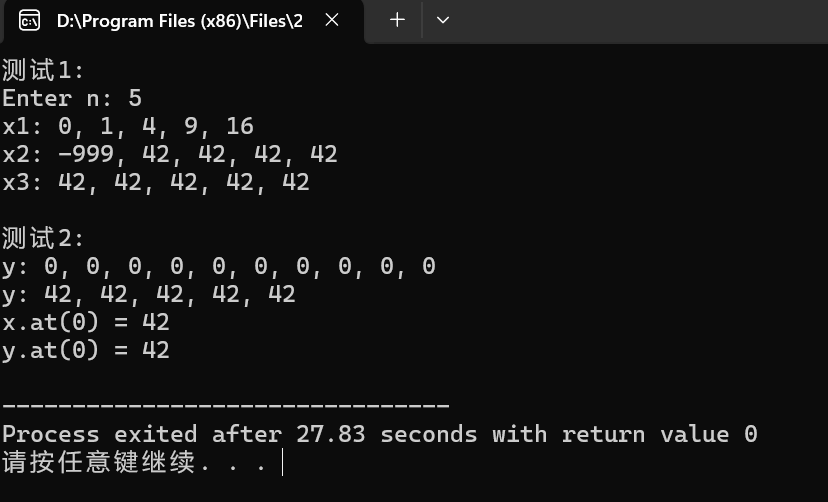
Q1:深复制
Q2:不可以运行,修改完之后数据有安全风险
实验任务4:
matrix.hpp
#pragma once
#include <cassert>
#include <iostream>
using std::cout;
using std::endl;
// 类Matrix的声明
class Matrix {
public:
Matrix(int n, int m); // 构造函数,构造一个n*m的矩阵, 初始值为value
Matrix(int n); // 构造函数,构造一个n*n的矩阵, 初始值为value
Matrix(const Matrix &x); // 复制构造函数, 使用已有的矩阵X构造
~Matrix();
void set(const double *pvalue); // 用pvalue指向的连续内存块数据按行为矩阵赋值
void clear(); // 把矩阵对象的值置0
const double &at(int i, int j) const; // 返回矩阵对象索引(i,j)的元素const引用
double &at(int i, int j); // 返回矩阵对象索引(i,j)的元素引用
int get_lines() const; // 返回矩阵对象行数
int get_cols() const; // 返回矩阵对象列数
void display() const; // 按行显示矩阵对象元素值
private:
int lines; // 矩阵对象内元素行数
int cols; // 矩阵对象内元素列数
double *ptr;
};
// 类Matrix的实现:待补足
Matrix::Matrix(int n, int m) : lines(n), cols(m) {
ptr = new double[n * m];
clear();
}
Matrix::Matrix(int n) : Matrix(n, n) {}
Matrix::Matrix(const Matrix &x) : lines(x.lines), cols(x.cols) {
ptr = new double[lines * cols];
for (int i = 0; i < lines * cols; i++)
ptr[i] = x.ptr[i];
}
Matrix::~Matrix() {
delete[] ptr;
}
void Matrix::set(const double *pvalue) {
for (int i = 0; i < lines * cols; i++)
ptr[i] = pvalue[i];
}
void Matrix::clear() {
for (int i = 0; i < lines * cols; i++)
ptr[i] = 0;
}
const double &Matrix::at(int i, int j) const {
assert(i >= 0 && i < lines && j >= 0 && j < cols);
return ptr[i * cols + j];
}
double &Matrix::at(int i, int j) {
assert(i >= 0 && i < lines && j >= 0 && j < cols);
return ptr[i * cols + j];
}
int Matrix::get_lines() const {
return lines;
}
int Matrix::get_cols() const {
return cols;
}
void Matrix::display() const {
for (int i = 0; i < lines; i++) {
for (int j = 0; j < cols; j++) {
cout << ptr[i * cols + j] << " ";
}
cout << endl;
}
}
tas4.cpp
#include "matrix.hpp"
#include <cassert>
#include <iostream>
#include <numeric>
using std::cin;
using std::cout;
using std::endl;
const int N = 1000;
// 输出矩阵对象索引为index所在行的所有元素
void output(const Matrix &m, int index) {
assert(index >= 0 && index < m.get_lines());
for (auto j = 0; j < m.get_cols(); ++j)
cout << m.at(index, j) << ", ";
cout << "\b\b \n";
}
void test1() {
double x[1000];
std::iota(x, x + N, 1); // 用1到N初始化数组x
int n, m;
cout << "Enter n and m: ";
cin >> n >> m;
Matrix m1(n, m); // 创建矩阵对象m1, 大小n×m
m1.set(x); // 用一维数组x的值按行为矩阵m1赋值
Matrix m2(m, n); // 创建矩阵对象m1, 大小m×n
m2.set(x); // 用一维数组x的值按行为矩阵m1赋值
Matrix m3(2); // 创建一个2×2矩阵对象
m3.set(x); // 用一维数组x的值按行为矩阵m4赋值
cout << "矩阵对象m1: \n";
m1.display();
cout << endl;
cout << "矩阵对象m2: \n";
m2.display();
cout << endl;
cout << "矩阵对象m3: \n";
m3.display();
cout << endl;
}
void test2() {
Matrix m1(2, 3);
m1.clear();
const Matrix m2(m1);
m1.at(0, 0) = -999;
cout << "m1.at(0, 0) = " << m1.at(0, 0) << endl;
cout << "m2.at(0, 0) = " << m2.at(0, 0) << endl;
cout << "矩阵对象m1第0行: ";
output(m1, 0);
cout << "矩阵对象m2第0行: ";
output(m2, 0);
}
int main() {
cout << "测试1: \n";
test1();
cout << "测试2: \n";
test2();
}
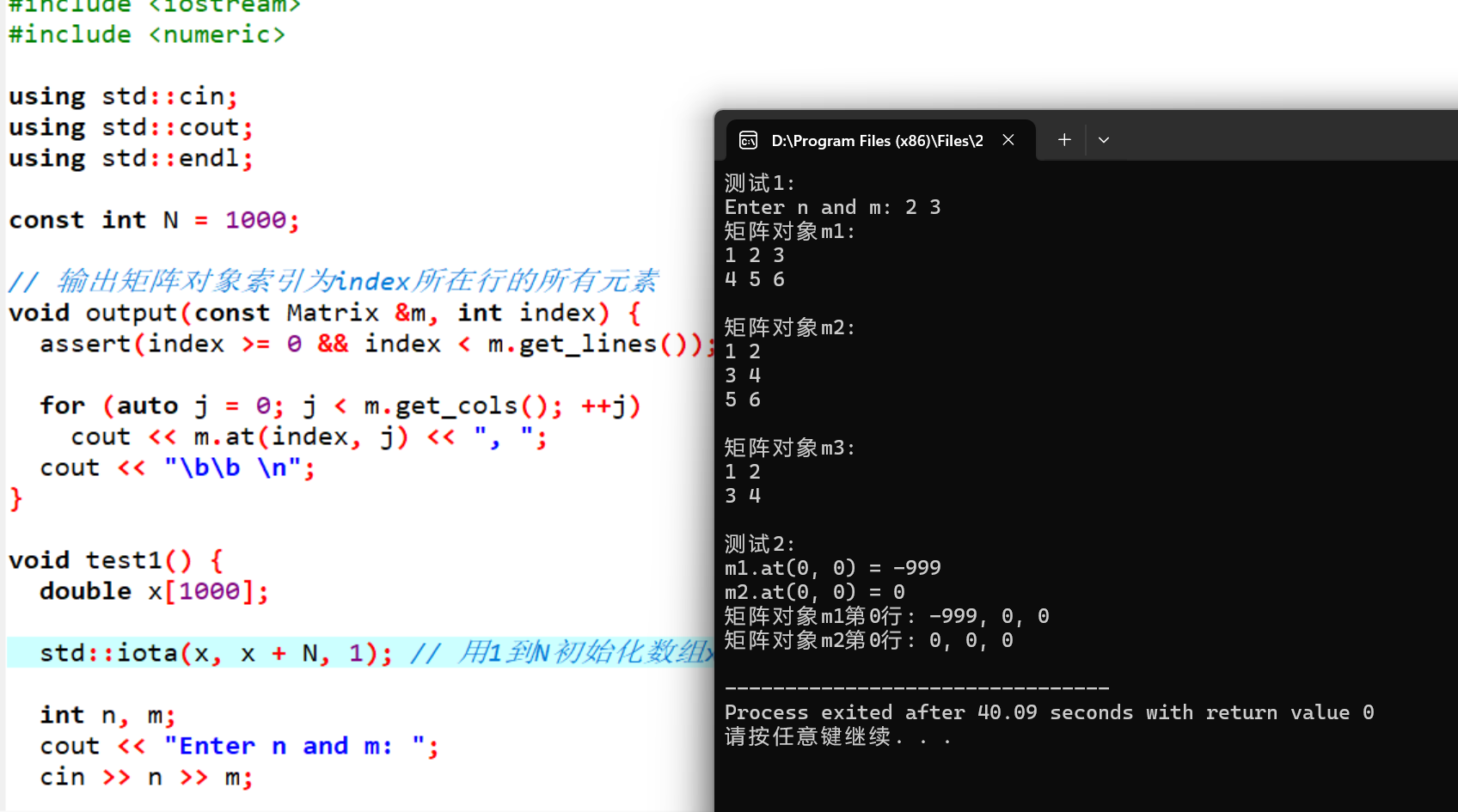
实验任务5
user.hpp
#pragma once
#include<iostream>
#include<vector>
using namespace std;
class User {
public:
User(const string& name1, const string& password1="123456", const string& email1="");
void set_email();
void change_password();
void display() const;
private:
string name;
string password;
string email;
};
User::User(const string& name1, const string& password1, const string& email1) :name { name1 }, password { password1 }, email { email1 } {
}
void User::set_email() {
cout << "Enter email address: ";
string emaill;
cin >> emaill;
while (1) {
if (emaill.find('@') != string::npos) {
email = emaill;
cout << "email is set successfully..." << endl;
break;
} else {
cout << "illegal email.Please re-enter email: ";
cin >> emaill;
cout;
}
}
}
void User::change_password() {
cout << "Enter old password: ";
string password1;
cin >> password1;
int cnts = 1;
while (cnts < 3) {
if (password1 == password) {
cout << "new password: ";
cin >> password1;
password = password1;
cout << "new password is set successfully..." ;
break;
} else {
cout << "password input error. Please re-enter agagin";
cin >> password1;
cnts++;
}
}
if (cnts == 3) cout << "password input error.Please try after a while" << endl;;
}
void User::display()const {
cout << "name: " << name << endl;
cout << "pass: " << password << endl;
cout << "email: " << email << endl;
}
task5.cpp
#include "user.hpp"
#include <iostream>
#include <vector>
#include <string>
using std::cin;
using std::cout;
using std::endl;
using std::vector;
using std::string;
void test() {
vector<User> user_lst;
User u1("Alice", "2024113", "Alice@hotmail.com");
user_lst.push_back(u1);
cout << endl;
User u2("Bob");
u2.set_email();
u2.change_password();
user_lst.push_back(u2);
cout << endl;
User u3("Hellen");
u3.set_email();
u3.change_password();
user_lst.push_back(u3);
cout << endl;
cout << "There are " << user_lst.size() << " users. they are: " << endl;
for(auto &i: user_lst) {
i.display();
cout << endl;
}
}
int main() {
test();
}
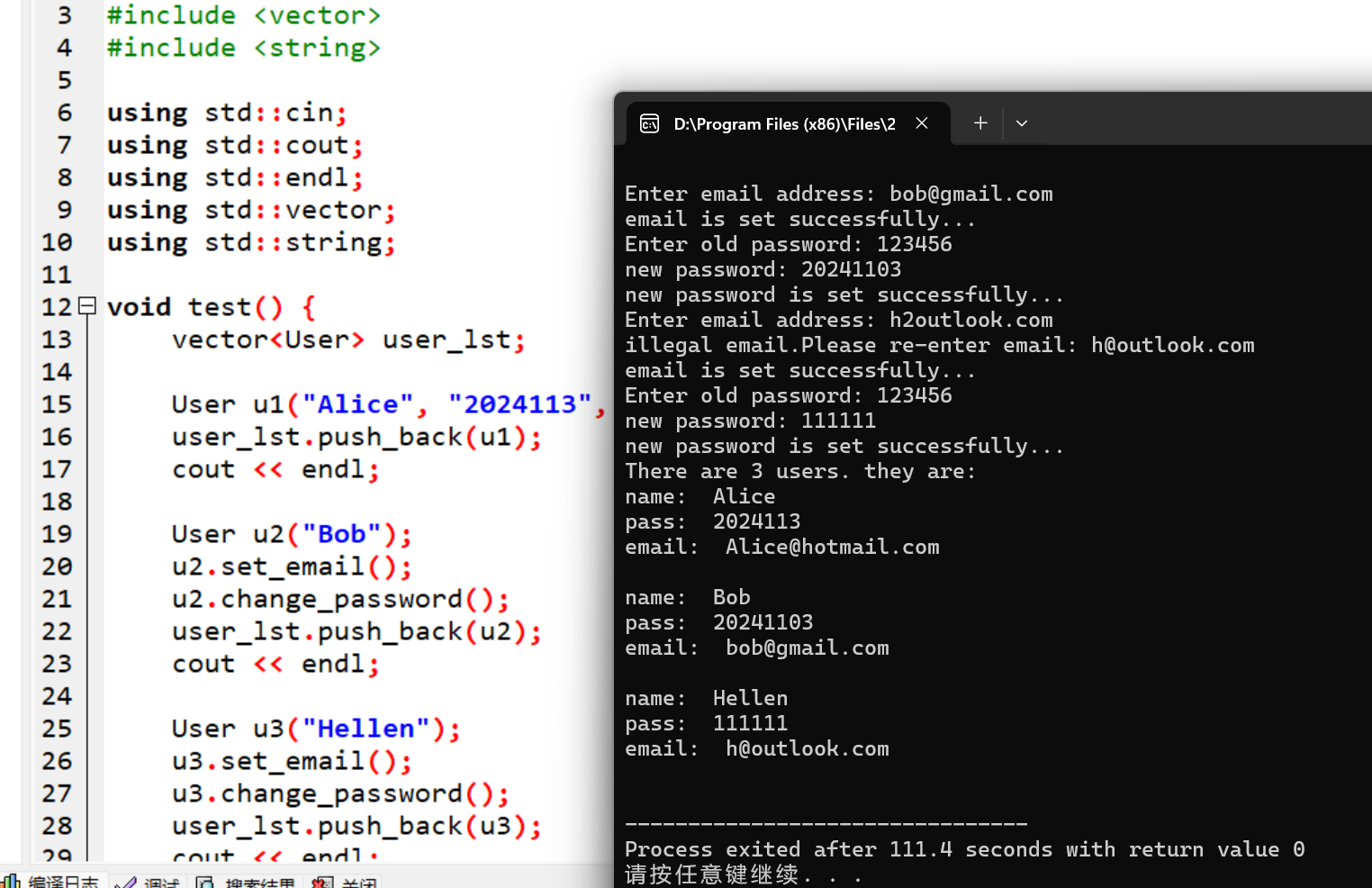
实验任务6:
account.hpp
#pragma once
#include"date.hpp"
#include<string>
#include<cmath>
#include<iostream>
using namespace std;
class SavingsAccount {
private:
string id;
double balance;
double rate;
Date lastDate;
double accumulation;
static double total;
void record(const Date& date, double amount, const string& desc);
void error(const string& msg) const;
double accumulate(const Date& date)const {
return accumulation + balance * date.distance(lastDate);
}
public:
SavingsAccount(const Date& date, const string& id, double rate);
const string& getId()const {
return id;
}
double getBalance()const {
return balance;
}
double getRate()const {
return rate;
}
static double getTotal() {
return total;
}
void deposit(const Date& date, double amount, const string& desc);
void withdraw(const Date& date, double amount, const string& desc);
void settle(const Date& date);
void show() const;
};
double SavingsAccount::total = 0;
SavingsAccount::SavingsAccount(const Date& date, const string& id, double rate) :
id(id), balance(0), rate(rate), lastDate(date), accumulation(0) {
date.show();
cout << "\t#" << id << "created" << endl;
}
void SavingsAccount::record(const Date& date, double amount, const string& desc) {
accumulation = accumulate(date);
lastDate = date;
amount = floor(amount * 100 + 0.5) / 100;
balance += amount;
total += amount;
date.show();
cout << "\t#" << id << "\t" << amount << "\t" << balance << "\t" << desc << endl;
}
void SavingsAccount::error(const string& msg) const {
cout << "Error(#" << id << "):" << msg << endl;
}
void SavingsAccount::deposit(const Date& date, double amount, const string& desc) {
record(date, amount, desc);
}
void SavingsAccount::withdraw(const Date& date, double amount, const string& desc) {
if (amount > getBalance())
error("not enough money");
else
record(date, -amount, desc);
}
void SavingsAccount::settle(const Date& date) {
double interest = accumulate(date) * rate / date.distance(Date(date.getYear() - 1, 1, 1));
if (interest != 0) record( date,interest,"interest" );
accumulation = 0;
}
void SavingsAccount::show()const {
cout << id << "\tBalance: " << balance;
}
date.hpp
#pragma once
#include<iostream>
#include<cstdlib>
using namespace std;
class Date {
private:
int year;
int month;
int day;
int totalDays;
public:
Date(int year, int month, int day);
int getYear()const {
return year;
}
int getMonth()const {
return month;
}
int getDay()const {
return day;
}
int getMaxDay()const;
bool isLeapYear()const {
return year % 4 == 0 && year % 100 != 0 || year % 400 == 0;
}
void show() const;
int distance(const Date& date)const {
return totalDays - date.totalDays;
}
};
namespace {
const int DAYS_BEFIRE_MONTH[] = { 0,31,59,90,120,151,181,212,243,273,304 ,334,365 };
}
Date::Date(int year, int month, int day) :year(year), month(month), day(day) {
if (day <= 0 || day > getMaxDay()) {
cout << "Invalid date: ";
show();
cout << endl;
exit(1);
}
int years = year - 1;
totalDays = years * 365 + years / 4 - years / 100 + years / 400 + DAYS_BEFIRE_MONTH[month - 1] + day;
if (isLeapYear() && month > 2) totalDays++;
}
int Date::getMaxDay()const {
if (isLeapYear() &&month == 2)
return 29;
else return DAYS_BEFIRE_MONTH[month] - DAYS_BEFIRE_MONTH[month - 1];
}
void Date::show()const {
cout << getYear() << "-" << getMonth() << "-" << getDay();
}
task.cpp
#include"account.hpp"
#include<iostream>
using namespace std;
int main() {
Date date { 2008,11,1 };
SavingsAccount accounts[] = {
SavingsAccount(date,"03755217",0.015),
SavingsAccount(date,"02342342",0.015)
};
const int n = sizeof(accounts) / sizeof(SavingsAccount);
accounts[0].deposit(Date(2008, 11, 5), 5000, "salary");
accounts[1].deposit(Date(2008, 11, 25), 10000, "sell stock 0323");
accounts[0].deposit(Date(2008, 12, 5), 5500, "salary");
accounts[1].withdraw(Date(2008, 12, 20), 4000, "buy a laptop");
cout << endl;
for (int i = 0; i < n; i++) {
accounts[i].settle(Date(2009, 1, 1));
accounts[i].show();
cout << endl;
}
cout << "Total: " << SavingsAccount::getTotal() << endl;
return 0;
}
